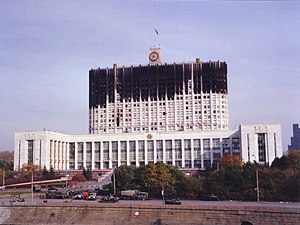User:David šlinc/sandbox
Cite error: There are <ref group=note> tags on this page, but the references will not show without a {{reflist|group=note}} template (see the help page).
- ^ "Russia's New Foreign Policy" (PDF). American Enterprise Institute for Public Policy Research. p. 5. Retrieved 2023-02-10.
Hence their wholehearted support for Yeltsin in his September–October 1993 confrontation with the Left-nationalist radical supporters of the Supreme Soviet. The Czech President Václav Havel said October 4 that the clashes in Moscow were not simply "a power struggle, but rather a fight between democracy and totalitarianism." In a joint statement Presidents Lennart Meri of Estonia, Guntis Ulmanis of Latvia, and Algirdas Brazauskas of Lithuania called the struggle in Moscow "a contest between a democratically elected President and antidemocratic power structures." Their Moldovan counterpart, Mircea Snegur, called the Supreme Soviet supporters "Communist, imperialist forces who want to turn Russia into a concentration camp". "In my thoughts I am on the barricades with the defenders of Russian democracy, as I was next to them in August 1991," Eduard Shevardnadze said in a message to the Kremlin on the late afternoon of October 3, 1993, when the outcome looked quite grim for Yeltsin. "Deeply concerned about the events in Moscow, I am again expressing my resolute support for President Yeltsin and his allies."
- ^ "Yeltsin Receives Widespread Backing for Assault". Washington Post. 4 October 1993.
- ^ ""Russian Revolution of October 1993" seen from office of Moldova's ambassador in Moscow. Op-Ed by Anatol Țăranu, ex-ambassador of Moldova to Russia". IPN press agency. 2023-09-28. Retrieved 2024-01-22.
Unlike Chisinau, the leaders of the Transnistrian separatists supported almost openly the Rutskoy-Khasbulatov camp, sending paramilitaries from Transnistria to the Russian capital to defend the White House. On October 4, the Moldovan ambassador in Moscow gave an interview for the Russian press, in which he warned about the presence of representatives of paramilitary detachments of the Transnistrian separatists among the defenders of the White House.
Cite error: There are <ref group=lower-alpha> tags or {{efn}} templates on this page, but the references will not show without a {{reflist|group=lower-alpha}} template or {{notelist}} template (see the help page).

